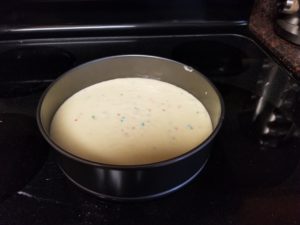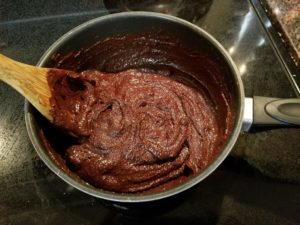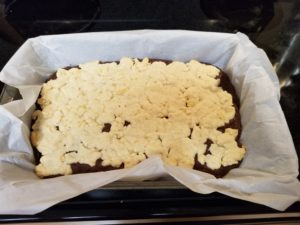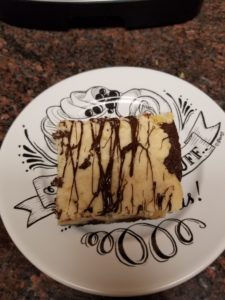
Ever wondered what the percentage on the chocolate packaging was referring to or if white chocolate was really chocolate or why chocolate chips stay in chip form when you bake them? I know I have.
Today we are going to discuss the differences between the different chocolates and the different forms of chocolate, so you can have a better understanding of what type of chocolate you need to use for baking.
Let’s get started…
Chocolate
Chocolate according to Wikipedia is “a range of foods derived from cocoa (cacao), mixed with fat (e.g., cocoa butter) and finely powdered sugar to produce a solid confectionery”. The different types of chocolate are classified based on how much pure chocolate (chocolate liquor) is in the mixture. The name designations of chocolate are sometimes subjected to international government regulation and each government can have different standards. For our purposes today, we will be talking about chocolate as regulated by the United States.
Now to understand how we get the different types of chocolate and what goes into chocolate we need to understand how the cacao bean gets processed into chocolate liquor, one of the main ingredients that differentiates chocolate. In a previous post I wrote about the science of chocolate, which included how the bean gets processed into the chocolate liquor, so I will not get into it here. If you need a refresher you can read my post The Sweet Science of Chocolate. Basically, the beans are processed and liquefied into something called chocolate liquor (the non-alcoholic version). Chocolate liquor is cocoa solids and the cocoa butter. It is chocolate in its purest form.
Now we can start talking about percentages of chocolate that you see on the chocolate packaging labels. The percentage refers to the amount of pure chocolate liquor in the chocolate mixture. It is basically the percent of what is left after you add up the sugar, dairy, vanilla, emulsifiers, and other flavorings. The FDA sets minimum percentages for the different types of chocolates.
Time to get into the specifics…
Unsweetened Chocolate

Unsweetened chocolate is completely chocolate liquor with no sugar added. It is extremely bitter and not good for eating, so it is primarily used for cooking and baking. It is used when a recipe is made with a lot of sugar.
Unsweetened cocoa powder is pulverized cocoa solids left after extracting all the cocoa butter. Cocoa powder is used as chocolate in baking and for chocolate drinks. There are two types of cocoa powder: natural cocoa powder created from the Broma process and Dutch process cocoa. Natural cocoa is light brown and is used mainly for baking in recipes that call for baking soda since this powder doesn’t contain alkali. Dutch process cocoa is processed with alkali to neutralize the acidity. It is milder in taste and darker in color. It is frequently used in chocolate drinks, such as hot chocolate, due its ease in mixing with liquids.
Dark Chocolate

Dark chocolate, aka plain chocolate, is produced using a higher percentage of cocoa with all fat coming from cocoa butter and not dairy. Dark chocolate is the European designation whereas bittersweet and semisweet is the United States designation. Dark chocolate has a minimum of 35% cocoa liquor. Semisweet usually has a little more sugar than bittersweet, but the designation is up to the manufacturer. Very dark chocolate can be up to 80% cocoa liquor. 65% to 70% cocoa liquor is most common for baking and eating. It is strong, but not overpowering. The higher the percent of cocoa liquor, the more bitter and brittle the chocolate is.
Dark chocolate is the most versatile chocolate. Semisweet chocolate chips are common for chocolate chip cookies. Bittersweet and semisweet chocolate can be easily interchanged when baking. Dark chocolate can have a very fruity taste, while others can be smoother. This depends on sourcing of the cacao bean. The darker the chocolate is, the more nutrients the chocolate has.
Milk Chocolate

Milk chocolate must contain 12% milk in the form of powdered, liquid or condensed and a minimum of 10% chocolate liquor. Some higher quality milk chocolates can contain up to 30 to 40% chocolate liquor. The rest is comprised of sugar, emulsifiers, and sometimes flavorings. Milk chocolate has a milder flavoring than dark chocolate.
Milk chocolate was invented by a Swiss confectioner, Daniel Peter, in 1875. He mixed chocolate liquor with condensed milk. Fun fact, condensed milk was invented by Henri Nestlé who was Daniel’s neighbor. The Hershey Company located in Hershey, Pennsylvania is the largest producer in the United States and Cadbury is the leading brand of milk chocolate in the United Kingdom.
Milk chocolate has a softer texture and melts easier than dark chocolate due to the added dairy. It is also sweeter and less bitter than dark chocolate. Because it melts easier and is sweeter, milk chocolate is a great eating chocolate. It can be used in baking, but its sweetness can cause an already sweet dessert to become too sweet. I generally use milk chocolate to dip things into such as truffles or pretzels.
White Chocolate

The age-old question is if white chocolate is really chocolate. The answer is no. Technically and legally white chocolate is not chocolate because it contains no cocoa solids. White chocolate is pure cocoa butter, dairy, and sugar. According to the FDA white chocolate has a minimum of 20% cocoa butter and 14% milk, cream or milk solids. Often vanilla is added to help sweeten the chocolate along with sugar. White chocolate is pale ivory in color and lacks the fruity and bitter taste that chocolate with cocoa solids have. It is usually sweet and creamy.
Compound Chocolate

Compound chocolate, more commonly known as candy melts or chocolate-flavored coating, is chocolate with the cocoa butter replaced by vegetable fat. This chocolate melts easy and is easy to work with since it doesn’t need to be tempered. Compound chocolate is usually used for dipping for decorating and comes in a wide variety of colors and flavors. It is most commonly found in the baking section of craft stores.
Chocolate Chips

Chocolate chips are bite size morsels of chocolate about 0.39 inches in diameter. They are made with less cocoa butter than regular chocolate and contain additives to retain their shape when heated. Originally chocolate chips were semisweet, but now come in different flavors such as mint and butterscotch. They can be used in a wide variety of recipes, but most commonly used in the chocolate chip cookie.
According to Wikipedia, “Chocolate chips were created with the invention of chocolate chip cookies in 1937 when Ruth Graves Wakefield of the Toll House Inn in the town of Whitman, Massachusetts added cut-up chunks of a semi-sweet Nestlé chocolate bar to a cookie recipe. (The Nestlé brand Toll House cookies is named for the inn.) The cookies were a huge success, and Wakefield reached an agreement in 1939 with Nestlé to add her recipe to the chocolate bar’s packaging in exchange for a lifetime supply of chocolate. Initially, Nestlé included a small chopping tool with the chocolate bars. In 1941, Nestlé and at least one of its competitors started selling the chocolate in “chip” (or “morsel”) form”.
Modeling Chocolate

Modeling chocolate is a chocolate paste made by melting chocolate and mixing it with corn syrup, glucose syrup, or golden syrup. Modeling chocolate is primarily used to make decorations for cakes and pastries that can’t be done with buttercream or fondant. Modeling chocolate can be dark, milk or white.
Now that you have a better understanding of the different types of chocolate, you can be better educated when making chocolate choices for your recipes. Happy baking!
References
https://www.bonappetit.com/story/types-of-chocolate
https://en.wikipedia.org/wiki/Types_of_chocolate
https://en.wikipedia.org/wiki/Modeling_chocolate
https://www.bhg.com/recipes/desserts/chocolate/chocolate-types-selection-storage/










































